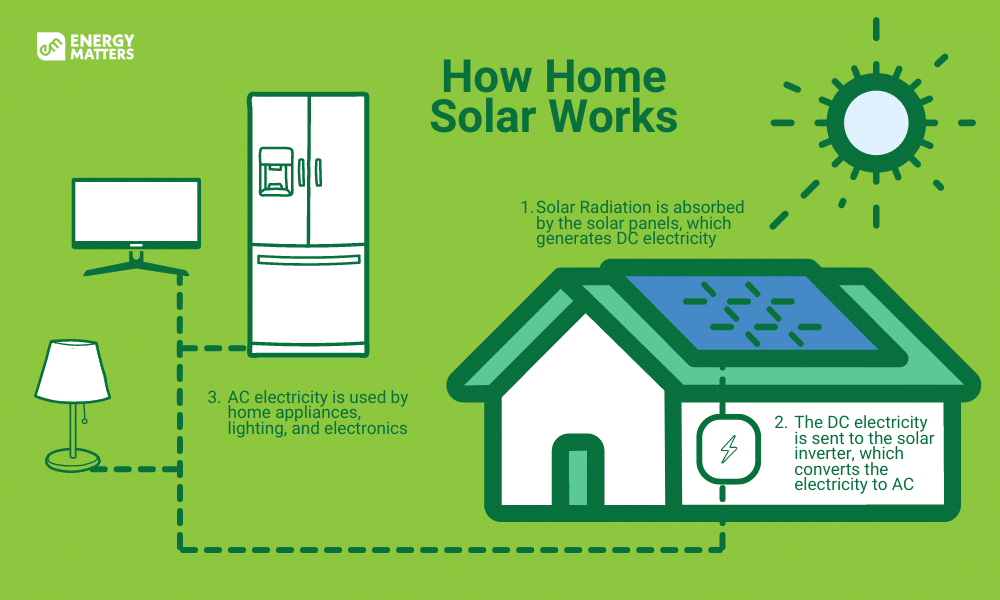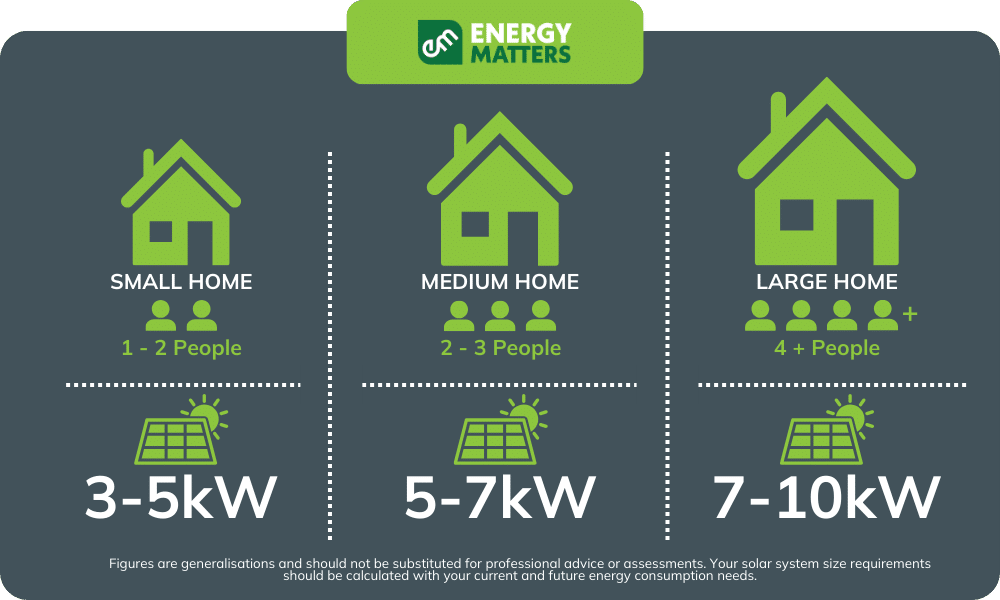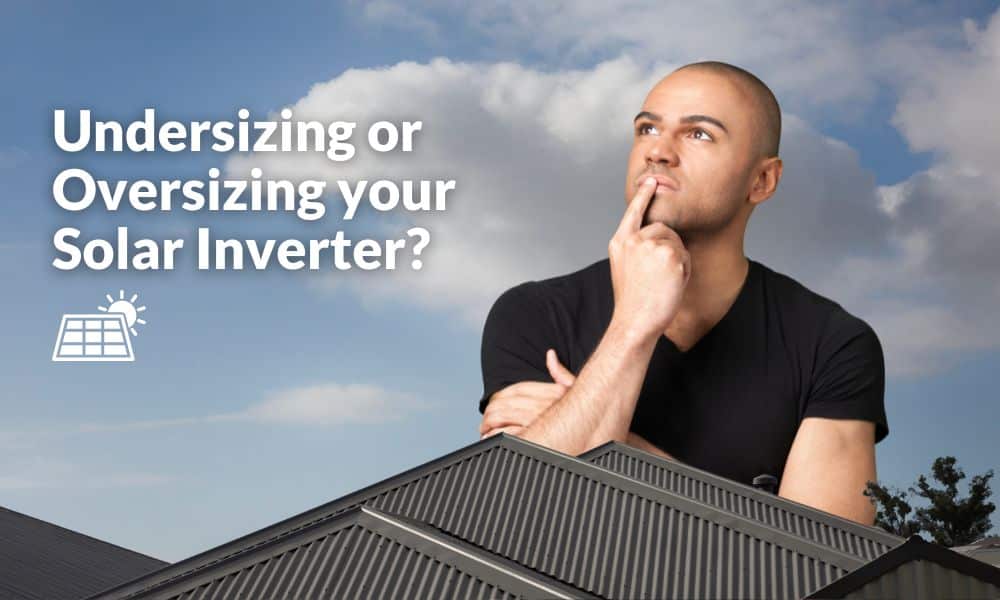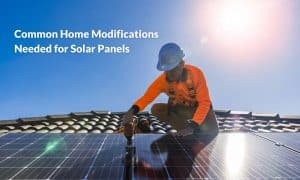Installing solar on your home or business comes with many questions. One of the very first you will be asked is how much electricity you currently use. This information, and other factors, will help your solar installer determine how much solar your home or business needs. Something they will consider is the type and size of solar inverter they will use. Undersizing and oversizing your inverter will have different implications for your home or business. Let’s take a look at what undersizing and oversizing your solar inverter means.
Back to basics: What is a solar inverter?
It is important to first understand the role of a solar inverter in your solar system. A standard home or business solar PV system will consist of 2 main components: Solar panels and a solar inverter. The panels absorb sunlight and create DC electricity. DC electricity is generally not used in most homes and businesses and requires inverting (or converting) to AC electricity. This is the role of the inverter. Your solar inverter will take the DC electricity and convert it into usable electricity to power all the appliances and electronics in your home or business.

What sizes do solar inverters come in?
Solar inverters, like the ones manufactured by GoodWe, Sungrow, FIMER, Fronius, Sigenergy, and LAVO, all come with different capacities. The amount of solar panels, and their combined output, generally determines the size of the inverter you will have installed. If you have 10 solar panels, all with an output of 400W, then you will need a 4kW inverter (10 x 400W = 4kW).
Each inverter manufacturer will have varying sizes available and they can range from as little as 1.5kW to over 1MW!
What is under and oversizing?
The language around under/oversizing can be a little confusing. To ensure that we are all on the same page, this is what we are referring to in this article:
- Undersized inverter: A smaller solar inverter compared to the number of solar panels/output installed, ie, 4kW of solar panels installed with a 3kW solar inverter
- Oversized inverter: A larger solar inverter compared to the number of solar panels/output installed, ie, 4kW of solar panels installed with a 5kW solar inverter
Oftentimes the terms are interchangeable, but it depends on whether you are referring to the inverter or the number of solar panels. You may also hear of ‘overclocking’ of your solar inverter – this is the same as undersizing.
What is solar inverter undersizing?
Now that we are on the same page, let’s talk about undersizing your inverter! Undersizing is not only common but usually recommended. When you hear of a 6.6kW solar system, this will mean that there are 6600W of solar panels installed with a 5kW inverter. The reason why this happens is that almost all solar inverters are rated for 33% more than the nameplated output. This means that you can maximise the amount of solar you have installed without having to increase the size of the inverter. Otherwise, you would need a 7kW inverter for a 6.6kW system
Why would I undersize my solar inverter?
There are many reasons to undersize your inverter:
- Cheaper: Installing a 5kW inverter will usually be cheaper than installing a 7kW variant. In fact, many manufacturers do not offer simple steps up in inverter ratings. You may have a choice between a 5kW and a 10kW inverter. If you’re not planning on installing 10kW plus of solar panels then a 5kW inverter would be the economical decision.
- Maximise STCs: Purchasing a larger inverter might negate the savings you will receive on your STCs. A smaller inverter with maximised solar panels will attract a greater return when claiming the STCs.
- More efficient system: While a solar panel may be rated for 400W of solar production, the panels will not produce this 100% during daylight hours. Maximising your inverter, and installing more solar panels, will mean that your system will be able to produce more electricity. This is especially true for split arrays. If you have panels on various orientations of your roof, only portions of your solar panels will receive direct sun at any point of the day. So, while you may have 6.6kW of panels, you might only produce 4.5kW of solar at any one point during the day.
- Distributor limitations: Your DNSP might have export caps and/or inverter capacity limitations. Depending on where you live, you may have a restriction on the size of the system you can install. Undersizing allows you to maximise the amount of electricity you can produce within the limitations of your DNSP.
- DC coupled battery and hybrid inverters: If you have a DC-coupled battery installed at the same time you install a hybrid inverter, you may be able to claim up to 100% more of STCs. This is all dependent on your hybrid inverter as well as the limitations imposed by your DNSP.

What is solar inverter oversizing?
Oversizing your solar system generally means that your solar inverter is oversized for the amount of solar panels and energy output you currently have. An example of this would be if you have 4kW of solar panels but a 5kW solar inverter.
Why would I oversize my solar inverter?
Oversizing your solar inverter would generally only occur for a few reasons.
- Adding to your solar system in the future: You may plan to add additional solar panels at a later date. Oversizing your inverter allows more capacity to be installed when you need it.
- Space limitations: If you plan to increase your solar capacity at a later date, you may not be able to fit 2 or more inverters in the future. Installing a larger inverter now will reduce the inverter space required.*
- Multiple orientations are needed: Many homes and businesses require split-arrays. Smaller solar inverters often only come with 1 or 2 MPPTs (strings). If you need 3 or more strings, a larger inverter with more MPPTs might be the way to go.
- Planning for distributor limitations: If your suburb or area is likely to expand then your DNSP might plan to limit solar exports or capacity in the future. Installing an oversized approved system now might allow you to increase your output capacity in the future without these restrictions imposed. For example, your DNSP might limit homes and businesses to 5kW in the future. Installing a 10kW inverter now will allow you to make full use of this in the future, even when your neighbours are limited to 5kW.
- Installer inverter stock: Your installer might have clearance or run out stock available in larger sizes at no extra cost.
*Such installations may come with difficulties later. We recommend speaking with your solar installer should you wish to expand your solar in the future.
What should I do? Should I undersize or oversize my inverter?
Generally speaking, we recommend undersizing where possible. You should see a faster return on investment as your upfront costs will be cheaper. If you do plan to increase your solar generation in the future, oversizing is certainly an option. You will need to weigh up the increased upfront cost now vs future installation costs and possible challenges.
The best way to find out what your home or business needs is to talk with a professional! Energy Matters offers an absolutely FREE and NO-OBLIGATION service to all of our readers. We will connect you with local solar installers who will provide you with quotes to help you go solar. They’ll discuss your current and future energy needs and design a system that best suits your home or business.
Click the link below to complete the quick quote request form.












































